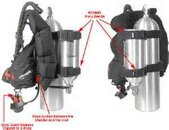dumpsterDiver
Banned
- Messages
- 9,003
- Reaction score
- 4,662
- # of dives
- 2500 - 4999
Doubles is also not practical for most recreational 14 yr old divers who are just learning..
Welcome to ScubaBoard, the world's largest scuba diving community. Registration is not required to read the forums, but we encourage you to join. Joining has its benefits and enables you to participate in the discussions.
Benefits of registering include
Fine, here:As for the left side reg, just give me a picture of it.. That is all I ask..

Are you just out looking for a fight?Ill advised, dangerous, not taught.... As for not taught, what agency recommends swimming around in the deep trying to consume our air supply as rapidly as possible to prepare for an emergency? I've not heard of that before.
A 6 cu-ft tank is smaller than many people would recommend, but I have used that amount of gas to make an ascent from over 100 ft. You can't screw around, you can't breath like a madman and you want to float up rather than kick hard.
I think that's the problem right here. The tool is being carried for precisely a situation when screwing around is very likely to happen!
Seriously, even though I think that at least a 30 is good in general, I understand that SAC (even SAC under stress) is to some degree proportional to body size, and for your 9 year old son a 6 might very well last him longer than a 30 would me...
About the kid..LOL... Actually he is 15 now and bigger, but he can go down to 80 ft (and back up) with zero air..
https://www.youtube.com/watch?v=xqOrsHnh96Q
It could. Except many 2nd stages can be converted to route the hose into the left side of the reg. Or you can just put it in normally, and stretch the hose a bit. Either way, the hose come from the left side and should tip off a situationally aware diver the grabbed the wrong reg.I'm still not sure of your hose routing. The image is hard for me to see, but it looks to me like a typical second stage will end up being upside down when routed over the shoulder or under the arm.
Too bad that in an OOA situation, all three of these are likely to happen. You can't state for sure what you'll do in a stressful event. The more air on hand, the better. Even a 30-40. Is not very bulky, and provides significantly more gas than a 6 cu ft, which is Lilly to last less than a minute at 100 ft under stess.A 6 cu-ft tank is smaller than many people would recommend, but I have used that amount of gas to make an ascent from over 100 ft. You can't screw around, you can't breath like a madman and you want to float up rather than kick hard.
It could. Except many 2nd stages can be converted to route the hose into the left side of the reg. Or you can just put it in normally, and stretch the hose a bit. Either way, the hose come from the left side and should tip off a situationally aware diver the grabbed the wrong reg.
Too bad that in an OOA situation, all three of these are likely to happen. You can't state for sure what you'll do in a stressful event. The more air on hand, the better. Even a 30-40. Is not very bulky, and provides significantly more gas than a 6 cu ft, which is Lilly to last less than a minute at 100 ft under stess.
And you're just being argumentative for the sake of arguing. What possible difference does it make if I have used this particular configuration or not? I understand it, and based on your repeated demand for a picture or a simplified explanation, you do not.Maybe the upside down regulator would be a good clue that the regulator is attached to the pony? I'm getting the feeling you haven't actually used the configuration you are discussing?
